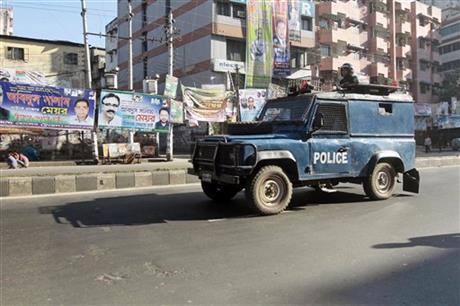
By JULHAS ALAM
A Bangladeshi security vehicle patrols on the second day of a four-day general strike in Dhaka, Bangladesh, Monday, Nov. 11, 2013. Opposition enforced a four-day general strike to force Prime Minister Sheikh Hasina to quit and form a caretaker government made up of people from outside of mainstream political parties to oversee an election next year. (AP Photo/A.M. Ahad)
Bangladesh Opposition Protest
Bangladeshi shopkeepers sit on sacks at a wholesale market on the second day of a four-day general strike in Dhaka, Bangladesh, Monday, Nov. 11, 2013. Opposition enforced a four-day general strike to force Prime Minister Sheikh Hasina to quit and form a caretaker government made up of people from outside of mainstream political parties to oversee an election next year. (AP Photo/A.M. Ahad)
Prev 1 of 2 Next
DHAKA, Bangladesh (AP) — Thousands of workers demanding higher pay hurled rocks and sticks at clothing factories and clashed with police who used tear gas against them Monday, bringing fresh scrutiny to working conditions in Bangladesh’s garment industry. At least 30 people were reported wounded.
The South Asian nation has seen three weeks of bloody political protests, and the demonstrations by garment workers only added to the chaos.
A government-appointed panel voted last week to raise the minimum wage for millions of garment workers to 5,300 takas ($66.25) a month — a raise by 77 percent but still the lowest minimum wage in the world. The workers have rejected the proposal, demanding 8,114 takas ($100) instead.
Factory owners have not endorsed it either and argue the proposed wage for an unskilled newcomer would increase their production cost significantly and destroy the industry in a fiercely competitive global market.
Bangladesh, the world’s second-largest garment manufacturing country after China, earns more than $20 billion a year from garment exports, mainly to the United States and Europe. The sector employs about 4 million workers, mostly women.
The Ministry of Labor would still have to approve the proposed amount to make it a law.
Bangladesh’s garment industry has come under scrutiny for its often harsh and unsafe conditions after the collapse of a factory building killed more than 1,100 people in April. In another horrific case, a fire last November killed 112 workers.
Mustafizur Rahman, director of the Industrial Police, said thousands protested and at least 100 factories were closed Monday in the Ashulia and Savar industrial areas to avoid further violence after the clash started in the morning.
Rahman would not say if there were any injuries, but Somoy TV station says up to 30 people were injured.
“The situation is under control now, but there is no chance to resume work in factories today (Monday),” he said. “We have remained alert.”
Another top police official of Dhaka district told The Associated Press by phone that they called in paramilitary border guards to aid police in the troubled areas as part of heightening security. The official spoke on condition of anonymity for safety reasons.
Monday’s chaos came amid a nationwide general strike enforced by the main opposition Bangladesh Nationalist Party and 17 allies to demand a caretaker government with people from outside political parties to oversee national elections due by early January.
Monday was the second day of an 84-hour general strike that ends Wednesday.
Despite disruptions during such strikes, authorities usually keep garment factories open to confirm shipment.
At least 19 people have died and hundreds have been injured in similar opposition protests since Oct. 26.
Prime Minister Sheikh Hasina wants to form an all-party caretaker government to hold the elections, but Zia has refused the proposal and asked Hasina to resign to pave the way for forming a government not aligned to any party. Hasina says she would go ahead with the plan to hold the elections by January taking other parties even if Zia does not come forward.



